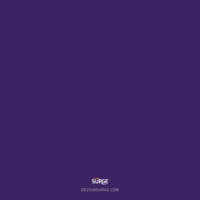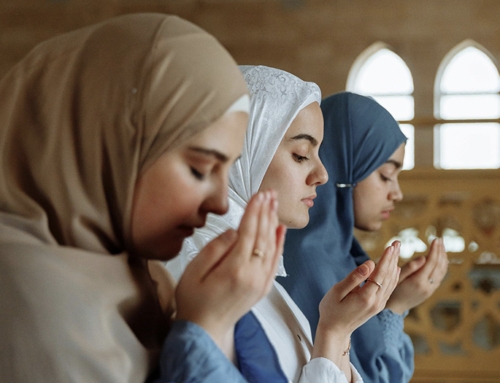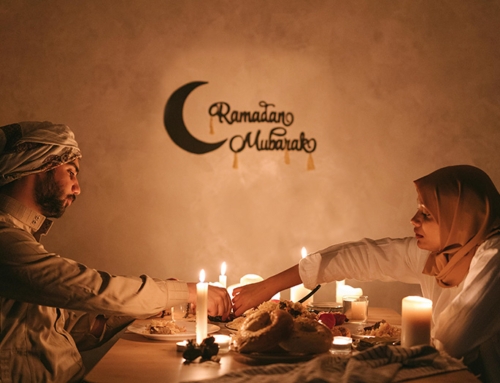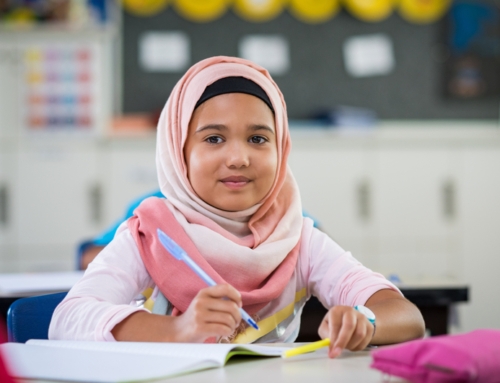By: Maheen Ahmad
Celebrating Ramadan in the Classroom
Every year when Ramadan rolls around, I ask my principal if I can be exempt from meetings for the next 30 days. He laughs his way out of a response, not realizing how genuine my request is. One day, I know he’ll come around, but until then, that’s our special Ramadan tradition.
Maybe you’re looking to start your own Ramadan traditions in your class? Or, maybe you’re an educator looking for a way to make your classroom more inclusive or a parent hoping to teach your child’s teacher and class about Ramadan? You’ve come to the right place. Check out the list of books, activities, and articles below to help you share what Ramadan is all about with your school.
Before we launch into the resources, here’s a very brief overview of Ramadan:
What is Ramadan?
Ramadan is the 9th holy month in which Muslims fast daily for about a month. The fast begins right before dawn and ends around sunset. Fasting during this month is one of the main major pillars of being a Muslim. Centuries ago, the first few verses of the Holy Quran were revealed during this month to Prophet Muhammad (peace be upon him). During the month, Muslims are encouraged to improve their thoughts and behaviors. It is generally a joyous time as Muslims are encouraged to reunite with family and friends, break the fast together, and infuse extra prayers throughout the month. It can also be a physically demanding month as sleep and food schedules are disrupted, and worship and self-reflection are prioritized. It’s important to note that because Muslims are a multiethnic group, there is no specific tradition that truly exclusively defines Ramadan or Eid. Cultural celebrations vary from group to group and from family to family.
When is It?
This year, Ramadan will begin on April 2, 2022 and will last until May 2. May 3 marks Eid ul Fitr, the festival to celebrate the end of fasting. The Islamic calendar is a lunar month. Therefore, it’s shorter by the Gregorian solar calendar by about 11 days, and, thus, the dates of Ramadan move throughout the year. Subsequently, there is no specific season associated with Ramadan – it can be during the winter, spring, summer, or fall. With Ramadan falling during the spring this year, it will undoubtedly impact spring break, standardized or AP testing during that time, and, of course, school.
Who Fasts?
Muslims who are above the age of puberty are expected to fast during the month of Ramadan. However, there are exemptions; pregnant women, menstruating women, anyone who is sick, or traveling is not required to fast. Of course, fasting is a very private matter, and asking someone why they are not fasting is disrespectful.
For more information about Ramadan, check out this Ramadan Guide for administrators and teachers. Although many schools are no longer using the virtual learning format, Teaching While Muslim has a great article from last year on the various ways that educators can still support their students during this month. Most of the strategies there are applicable for in-person as well. For any additional questions, check this Vox article about the top 9 Ramadan-related questions you may be embarrassed to ask.
Books & Activities
Of course, please note that I’ve categorized the following resources based on what grade bands I thought would be best. I urge all educators and parents to pre-read content before introducing it to students to ensure that any unfamiliar words or content can be researched ahead of time.
Elementary – K-5
For the younger students, there are a ton of colorful, engaging books about Ramadan that can be read aloud in class and can be used to start a conversation about the month.
-
- Ilyas and Duck: Ramadan Joy! by Omar S. Khawaja
This adorable picture book explores Ilyas and Duck and their experience with fasting during the month with an emphasis on encouraging good habits. It reminded me of a basic Ramadan version of How the Grinch Stole Christmas. Note that the book frequently uses the word Allah which is just the Arabic word for God. - Golden Domes and Silver Lanterns: A Muslim Book of Colors by Hena Khan
a. This is a very basic picture book that explores Muslim imagery using various colors. It mentions Ramadan briefly and is probably best suited for younger grades. - The Gift of Ramadan by Rabiah York Lumbard
a. Sophia’s experience with fasting goes awry in this delicately illustrated honest picture book intended for younger grades. In the end, she learns from her mistakes and appreciates the true gift of Ramadan. - It’s Ramadan, Curious George by H. A. Rey and Hena Khan
a. This classical lyrical picture book goes over Kareem’s experience with Ramadan as he fasts, eats, visits a mosque, and celebrates Eid with George. - Lailah’s Lunchbox: A Ramadan Story by Reem Faruqi
a.This beautifully illustrated picture book follows Lailah as she adapts to fasting in America for the first time and the insecurities that can come with being the only one celebrating a holiday. - Once Upon an Eid Edited by S.K Ali and Aisha Saeed
a.This anthology of about a dozen short stories (including a graphic novel short story!) is one of the best anthology books I have ever read. Each story champions hope and joy in some way, and nearly all of them connect to a Muslim holiday, whether Ramadan, Eid ul Fitr, or Eid ul Adha. Some of the stories are better suited for upper grades, but nearly all of them can be used when analyzing and discussing short stories. Some of the stories include cultural terminology associated with Ramadan and Islam, and they may require some background knowledge when sharing with students. - Sadiq and the Ramadan Gift by Siman Nuurali and Anjan Sarkar
a.This fantastically illustrated chapter book is part of a long-popular series about Sadiq. In this book, Sadiq and his friends explore the spirit of generosity and community during the month of Ramadan. Great for upper grades! - Student Essay: Ramadan, a month of reflection
a.This article from NEWSELA shares a reflection from a sixth grade student about what Ramadan means to her.
- Ilyas and Duck: Ramadan Joy! by Omar S. Khawaja
Middle Grades (6-8)
Although picture books are not typically used in middle school, a few of the ones mentioned above can be used to spark a conversation about Ramadan. Below are two longer texts that can also be read partially in class. In addition, there are also links to articles and videos that students can explore after a class conversation about Ramadan.
-
- Student Essay: Ramadan, a month of reflection
a. This article from NEWSELA shares a reflection from a sixth grade student about what Ramadan means to her. It can be a good way to introduce the month to students before sharing any of the other resources mentioned here. - Once Upon an Eid Edited by S.K Ali and Aisha Saeed
a. This anthology of about a dozen short stories (including a graphic novel short story!) is one of the best anthology books I have ever read. Each story champions hope and joy in some way, and nearly all of them connect to a Muslim holiday, whether Ramadan, Eid ul Fitr, or Eid ul Adha. Nearly all of them can also be infused when analyzing and discussing short stories. Some of the stories include cultural terminology associated with Ramadan and Islam, and they may require some background knowledge when sharing with students. - Sadiq and the Ramadan Gift by Siman Nuurali and Anjan Sarkar
a. This fantastically illustrated chapter book is part of a long-popular series about Sadiq. In this book, Sadiq and his friends explore the spirit of generosity and community during the month of Ramadan. Great quick read for middle schoolers! - Ramadan a time for “togetherness,” Dearborn family says
a. This article from NEWSELA talks about what Ramadan means to various residents of Dearborn, Michigan. - Ramadan Vlogs
a. Explore what a day in the life of a Muslim in Ramadan is like by exploring these vlogs. There’s a playlist of about six different vloggers and their experiences. - Here’s How 15 Athletes Train During Ramadan
a. Over the years, more and more athletes have shared how they fasted while juggling their athleticism. This Buzzfeed article goes into depth on how 15 contemporary athletes navigate that balance. - How My First Ramadan was Pretty Lit
a. Yara Elmjouie did not know what to expect when he fasted for the first time, but this fast-paced, short video documentary captures his roller coaster of an experience.
- Student Essay: Ramadan, a month of reflection
High School (9-12)
Infusing Ramadan in high school classrooms can look different from teacher to teacher. The following resources are a medley of fictional texts, blogs, vlogs, multimedia links, and articles that all explore some aspect of Ramadan. Teachers can discuss what Ramdan is briefly and then introduce any of the texts below to generate a dialogue about the month and how it is celebrated.
- Ramadan 2021: 9 questions about the Muslim holy month you were too embarrassed to ask – Vox
a. Although this article is from last year, it succinctly captures what Ramadan is, how it’s celebrated, and addresses questions many students may have. Great way to introduce the month before sharing any of the other resources below. - Once Upon an Eid Edited by S.K Ali and Aisha Saeed
a.This anthology of about a dozen short stories (including a graphic novel short story!) is one of the best anthology books I have ever read. Although intended for middle and elementary school students, stories from this anthology can also be enjoyed by high school students. Each story champions hope and joy in some way, and nearly all of them connect to a Muslim holiday, whether Ramadan, Eid ul Fitr, or Eid ul Adha. Nearly all of them can also be infused when analyzing and discussing short stories. Some of the stories include cultural terminology associated with Ramadan and Islam, and they may require some background knowledge when sharing with students. - Not Even Water – Stories of Ramadan
a. This interview style blog post shares the humorous experiences of three Muslim educators with Ramadan. - Ramadan: South Asia’s Dying Traditions on Waking up the Faithful
a.This article explores a very specific tradition in South Asia of waking people up for the early pre-dawn meal eaten in Ramadan and how the advent of technology has impacted it over the years. - Ramadan Vlogs
a.Explore what a day in the life of a Muslim in Ramadan is like by exploring these vlogs. There’s a playlist of about six different vloggers and their experiences. - This runner ran 161.5 miles while fasting during Ramadan and has raised £55,000 for charity
a. Ramadan experiences can differ from person to person, and this article follows the journey of a runner who chose to use run while fasting to raise money for charity. - Here’s How 15 Athletes Train During Ramadan
a.Over the years, more and more athletes have shared how they fasted while juggling their athleticism. This Buzzfeed article goes into depth on how 15 contemporary athletes navigate that balance. - How The Internet Helped Ramadan Feel Like Home Again
a. This article explores one graduate student’s journey from Ramadan as she struggles to celebrate the month by herself after moving away from her family and support group. - How My First Ramadan was Pretty Lit
a.Yara Elmjouie did not know what to expect when he fasted for the first time, but this fast-paced, short video documentary captures his roller coaster of an experience.
Another considerate touch is to add Ramadan-related GIFs to your instructional materials – you can find a ton on Giphy or check out a few below. Typically, during Ramadan, people often greet one another with Ramadan Mubarak, Ramadan Kareem, or Happy Ramadan.
Feel free to let us know what Ramadan traditions you’ll be infusing in your classroom or school this year. Thank you for taking the steps to make your school and classroom a more inclusive space. Looking for more resources on Islam and teaching Muslim students? Check out this teacher’s guide!
Ramadan Mubarak to all those celebrating!
Got Questions?
We have Answers. Get in touch now.











